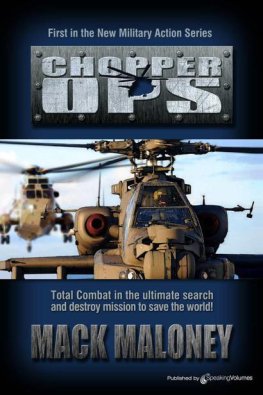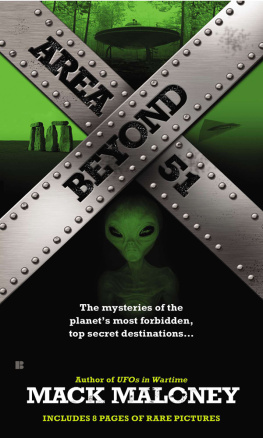Mack Maloney - Chopper Ops
Here you can read online Mack Maloney - Chopper Ops full text of the book (entire story) in english for free. Download pdf and epub, get meaning, cover and reviews about this ebook. City: Naples, FL, year: 2011, publisher: Berkley, genre: Detective and thriller. Description of the work, (preface) as well as reviews are available. Best literature library LitArk.com created for fans of good reading and offers a wide selection of genres:
Romance novel
Science fiction
Adventure
Detective
Science
History
Home and family
Prose
Art
Politics
Computer
Non-fiction
Religion
Business
Children
Humor
Choose a favorite category and find really read worthwhile books. Enjoy immersion in the world of imagination, feel the emotions of the characters or learn something new for yourself, make an fascinating discovery.
- Book:Chopper Ops
- Author:
- Publisher:Berkley
- Genre:
- Year:2011
- City:Naples, FL
- ISBN:978-1-61232-148-6
- Rating:4 / 5
- Favourites:Add to favourites
- Your mark:
- 80
- 1
- 2
- 3
- 4
- 5
Chopper Ops: summary, description and annotation
We offer to read an annotation, description, summary or preface (depends on what the author of the book "Chopper Ops" wrote himself). If you haven't found the necessary information about the book — write in the comments, we will try to find it.
Chopper Ops — read online for free the complete book (whole text) full work
Below is the text of the book, divided by pages. System saving the place of the last page read, allows you to conveniently read the book "Chopper Ops" online for free, without having to search again every time where you left off. Put a bookmark, and you can go to the page where you finished reading at any time.
Font size:
Interval:
Bookmark:
Mack Maloney
CHOPPER OPS
First in the New Military Action Series
For my good friend
Bob Bloomer
PART ONE
SEVEN GHOSTS
Chapter 1
Western Saudi Arabia
February 9, 1991
0200 hours
The American air base at Al-Khadi was a very secret place.
Located deep in the western Saudi desert, it appeared on no maps. The only road leading to it was 173 miles long, winding and unmarked. Barely a dozen people in the Saudi military knew the air base existed, and still they werent privy to its location. Even the U.S. Army engineers who built the place back in 1989 werent sure exactly where it was. They had been trucked to the site blindfolded when construction began. When they finished, they left the same way.
Air operations at Al-Khadi took place only at night. Extremely strict blackout restrictions were always in effect then. No lights. No radios. No electronic gear of any kind was permitted to be turned on unless absolutely necessary. Even the lighting of a match was forbidden without proper authorization.
Only one runway was open at Al-Khadi this fateful night. The rest of the base was shut up tight. The weather had something to do with this. An unusual desert fog had settled over the base earlier in the evening; it was so thick by midnight it resembled a snowstorm. The Saudis called this cold and wet phenomena el-fadehal, unwanted visitor from the west. Traditionally, it was an omen of bad luck.
A single airplane stood waiting in this murk, its four propellers turning and blowing waves of cold mist behind them. An eerie growl from the planes muffled engines washed across the desert floor, bouncing off the mountains that surrounded the air base. The ground crew moved like spirits under the planes wings and fuselage, emerging, then disappearing within the swirl of fog.
This particular aircraft had many names. Stout of body and thick in the nose, it was a variant of the ubiquitous C-130 Hercules cargo plane. Its official serial listing was AC-130/SO-21D. Since operating out of Al-Khadi, its radio call sign had invariably been Alpha One Blue. Its aircrew called the big plane The Space Hog. But the unusual aircraft was most readily known by the name of the secret unit to which it was attached: ArcLight 4.
The air war against Iraq had been going on for nearly a month now. Allied bombers were continuously pounding targets inside Iraq and occupied Kuwait. The ground assault to retake Kuwait would begin in just two weeks. In anticipation of this, the big ArcLight 4 airplane was about to take off on its thirteenth mission in as many days.
ArcLight 4 was not a bombernot a conventional one anyway. It was actually a combination spy plane and weapons platform. Its bulbous nose was stuffed with surveillance gearinfrared TV cameras, NightScopes, powerful electronic eavesdropping equipment. Its thick fuselage was packed with weaponry. Three M-134 7.62mm miniguns were mounted in portholes on the aircrafts left side. Essentially modern Gatling guns, these six-barreled weapons could each fire one hundred rounds a secondan incredible rate. The aircraft also carried a 105mm light howitzer, capable of firing a variety of ordnance including armor-piercing and high-explosive shells.
The aircraft delivered its fierce barrage by going into an orbit above a target, tipping on its left wing, and firing all four weapons at once. Such a fusillade could perforate an area the size of a football field in less than ten seconds. Mobile targets, troop concentrations, and such things as missile launchers and heavy guns were usually vaporized in even less time. Sustained firing by the gunships combined weaponry most often resulted in craters that seemed more at home on the moon.
The planes crew was a combination of sorts too. It was made up of U.S. Army Green Berets, U.S. Air Force officers, and Defense Intelligence Agency specialists. There were thirteen in all, and the delineation of duties was simple. The Green Berets handled the weapons, the DIA men ran the snooping equipment, and the Air Force guys flew the airplane. Each man on board had the highest security clearance possible.
On paper, the planes mission this night was the same as the previous twelve. Get airborne, turn on its snooping equipment, try to ascertain special targetsSCUD sites, biological or nerve-gas weapons depots, suspected nuclear storage facilitiesand then go in and hit them with the airplanes awesome weaponry.
So far in the war, ArcLight 4 had destroyed a half-dozen such targets in some very out-of-the-way places. The fuzzy border between Iraq and Iran had been one of them. Enclaves of pro-Saddam guerrillas hiding valuable equipment in the rugged hills of east Jordan had been another. One flight a week before had brought the secret airplane all the way up to the Turkish-Russian border to stop a column of arms smugglers heading for Saddams beleaguered troops. It was no surprise that the airplane carried no markings, no country insignia, no outward indication as to who it belonged to. After all, the airplanes modus operandi was to go places and do things no other Allied airplane could possibly do.
That was why its crew, its operations, and the airplane itself officially did not exist.
In many ways, it was a ghost.
* * *By 0235 hours, the plane was ready to go. It rolled out onto Runway East One, the only airstrip open. The base control tower turned on the double set of dull blue lights lining the runway, but only long enough for the big airplane to get itself positioned. Then they were switched off again. The pilots would have to rely on their NightVision goggles for the actual takeoff.
Waiting now at the end of the runway, the airplanes crew ran one last diagnostic check. All of the airplanes vitalsits engines, its fuel supply, its communications and backup gearwere in order. Its weapons systems were all lit green. Its tons of eavesdropping equipment were functioning in the high range as well.
This mission tonight had the makings of a fairly easy one. The crews orders called for it to sweep up Iraqs western border, cross over the top of Saddams domain, and then fly back down its eastern fringe. Total flying time, just under six hours. A Sunday drive compared to the fifteen-hour marathon flights the crew was used to doing.
That was why it was so odd then that after the strange airplane took off and disappeared into the cold misty night, it was never heard from again.
Chapter 2
Bethesda, Maryland
Ten years later
The phone call came just after 1 A.M.
It roused Gene Smitz out of his recurring dream about playing first base in the 1986 World Series. It was raining outside and in that first groggy moment, Smitz thought the ringing was the sound of raindrops hitting his window. But there was no rain that hard, his sleepy brain told him. Yanking himself out of his dream just as Mookie Wilsons dribbler was heading right for him, Smitz reached over and answered the phone.
The voice on the other end was a whisper, echoing and distant. That was how Smitz knew it was from his office.
You are needed at Bethesda Naval Hospital, the voice said. Second floor, Room 333. Its best you dont delay.
The cab driver had no problem with that. When Smitz said he needed to get to Bethesda Hospital as quickly as possible, the Sudanese cabbie drove the twenty-two miles in eighteen minutes. The ride was so wild it gave Smitz at least one strange thought: Was his life so ironic that he would be killed in a taxi rushing to a hospital?
They came closethe streets had turned slick in the chilly spring downpour. But somehow he arrived at Bethesda in one piece. And while he didnt know why he was being summoned to the Navy hospital, at least he was sure it didnt pertain to any member of his family. The Office would not have called him for that.
Font size:
Interval:
Bookmark:
Similar books «Chopper Ops»
Look at similar books to Chopper Ops. We have selected literature similar in name and meaning in the hope of providing readers with more options to find new, interesting, not yet read works.
Discussion, reviews of the book Chopper Ops and just readers' own opinions. Leave your comments, write what you think about the work, its meaning or the main characters. Specify what exactly you liked and what you didn't like, and why you think so.









